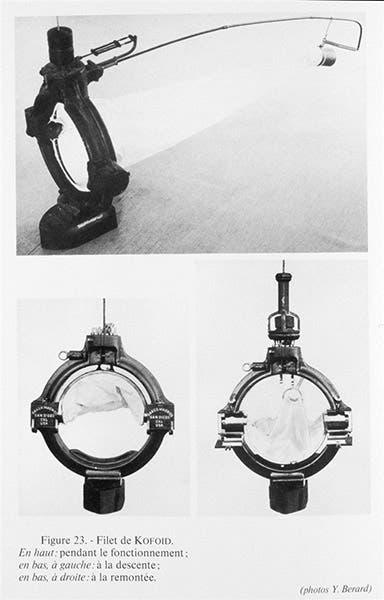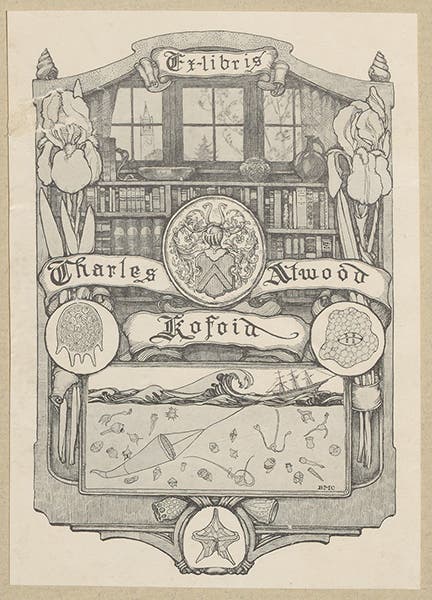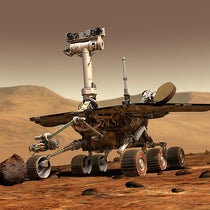Scientist of the Day - Charles Atwood Kofoid
Charles Atwood Kofoid, a marine invertebrate zoologist, was born Oct. 11, 1865. Kofoid spent most of his career in the Department of Zoology at the University of California at Berkeley, brought there by William Emerson Ritter. Kofoid was one of the world's experts on such marine life as dinoflagellates, and he distinguished himself well enough to be elected to the National Academy of Sciences. He teamed with Ritter to found a marine biology station in La Jolla, which became the Scripps Institution of Oceanography. He also invented a new kind of trawling net for plankton that could be closed or opened from the trawler, so that collecting could be pinpointed to a specific depth (second image). His best-known book was The Biological Stations of Europe (1910), which we have in our collections.
Important as he was in his own field, none of this would have secured Kofoid a place here as a Scientist of the Day. Fortunately, he was also a book collector. This was a passion that came to him later in life, but apparently it blossomed into an addiction. In a memorial notice for the National Academy of Sciences, the biographer noted that near the end of Kofoid’s career, you could hardly get into his office because of the endless stack of parcels from rare book dealers that blocked the doorway. It sounds as if Kofoid collected rather indiscriminately, which is not an especially noteworthy trait for a book collector and keeps him out of that elite group of discriminating collectors such as Harrison Horblit or H. Bradley Martin.
We include Kofoid in our series for two reasons. First, one of his books is now in our library, and it is one of the finest books we own. It is the Historia animalium, volume 1, On Quadrupeds, by Conrad Gessner, published in 1551. It is not only an important book in the history of zoology – perhaps THE most important book of the Renaissance on the subject – but Kofoid's copy, now our copy, has hand-colored woodcuts, and the coloring was and is superb. In our post on Gessner, the 2nd, 4th, 6th, and 8th images are from the Kofoid 1551 copy (the other illustrations are from our 1563 German edition of Gessner's natural history, which is also hand-colored). We republish one of those in our post today, the charming hedgehog (fourth image), because many decades ago, Bruce Bradley and I were charged with selecting an image for the Library's very first postcard. We chose the hedgehog from Kofoid's copy of Gessner; we affectionately called it Herbie, and Herbie slowly evolved into the Library's unofficial mascot, and eventually provided the name for the Library's quarterly house publication, The Hedgehog.
The second reason for inviting Kofoid into our Scientist-of-the-Day ranks is because he took the trouble to design, or have designed, a bookplate suitable for a marine biologist. We have many bookplates of former owners in our History of Science collection, but very few of them stand out in any way. Kofoid’s is terrific. We show you his bookplate from Gessner’s History of animals (fifth image).
The top scene of a library is rather generic, suitable for any kind of a book collector, or at least one who likes irises. But the bottom scene (sixth image, below) is specific to Kofoid, showing a marine environment, and a dredge, and lots of plankton and dinoflagellates waiting to be dredged. The humor of the scene suggests that Kofoid might have been inspired by the whimsical drawings of one of the fathers of marine invertebrate zoology, Edward Forbes. I don’t know if Kofoid also collected Japanese woodblock prints, but the whimsical inclusion of Hokusai’s famous Great Wave off Kanagawa, about to swamp the trawler, indicates that he might have.
The only other bookplate that I admire almost as much as Kofoid’s is that of Willy Ley, the 20th-century popular writer on rocketry; his bookplate is the last image in our post on Ley. We need more bookplates like these in our history of science books. If you are a present-day collector, please consider designing a bookplate appropriate for you and your collection, so that future perusers of your books can take as much delight in your bookplate as in the books themselves.
Dr. William B. Ashworth, Jr., Consultant for the History of Science, Linda Hall Library and Associate Professor emeritus, Department of History, University of Missouri-Kansas City. Comments or corrections are welcome; please direct to ashworthw@umkc.edu.











